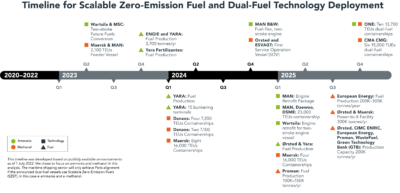This summer’s record-breaking heat waves in the northern hemisphere has many people spending their holidays near the ocean and coast. These heat waves have brought the realities of climate change to the forefront of our minds, similar to how the lines of ships off ports and empty shelves over the past two years have increased public awareness of the crucial role of maritime shipping in our global supply chain, as well as the sector’s greenhouse gas emissions problem. As a result of this growing awareness, there’s been increasing global pressure on the maritime sector to decarbonize, including from climate-leading cargo owners through Aspen Institute’s Cargo Owners for Zero Emission Vessels Initiative (coZEV).
As climate-leading cargo owners race to meet their increasingly ambitious decarbonization targets, and aim to align their shipping activity with the goals of the Paris Agreement, they find themselves heavily dependent on the deployment and scalability of new scalable zero-emission fuels (SZEFs) and technologies. Experts from the Global Maritime Forum and UMAS have said SZEFs need to be commercially deployed by the middle of this decade to ensure the maritime industry is on a trajectory to achieve Paris Agreement goals.
Announcements from key actors across the maritime value chain about a range of zero-emission technologies, like those made recently by Maersk, ONE, CMA CGM, YARA, Wärtsilä, MAN, and Ørsted give cause for optimism that deployment of zero-emission technologies and fuels and full sector decarbonization on an aggressive timeline is achievable. These announcements help build confidence for actors across the value chain, which can spur even greater investment in actionable pathways toward decarbonization.
In the context of our work as the facilitators of coZEV, a coalition of cargo owner companies with a shared ambition to only purchase zero-carbon shipping by 2040, the Aspen Institute Shipping Decarbonization Initiative team has taken a closer look at recent public announcements to understand the commercial viability and possible deployment timelines of SZEFs. We have developed a summary timeline of those announcements, and we’re sharing it today because we believe it may be a useful snapshot for other observers of this industry as well. The timeline gives our cargo owner partners a clue about investments in decarbonization they should expect from their service providers in the coming years, and builds confidence that these emerging fuels and technologies can be deployed in time to meet their demand on a sufficiently ambitious timeline. According to these announcements, cargo owners can expect around 30 “dual fuel” containerships on the water by the year 2025 that will be capable of using SZEFs.

While it’s great to see the action happening in this space thus far, these announcements have stimulated further questions: What actions are carriers taking to secure sufficient supply of SZEF so that the dual fuel vessels will operate with the right fuels? What’s the new engine deployment and existing vessel retrofit schedule? Will ports be ready to receive these new zero emission vessels? More broadly, in evaluating the zero emission future of the shipping sector, we’re eager for win-wins. We want to see more discussion of how carrier investments will support not only cargo owners’ long term climate ambitions, but also how they can help meet important business objectives around minimizing cost, increasing capacity, and improving reliability of the maritime transport system on which companies rely. These questions are particularly important now, after two hard years of supply chain disruption and astronomical freight rates. Finally, we also turn our gaze to those carriers who are still silent on their plans for investments in this urgently needed zero-emission transition.
The recent announcements enable climate leading cargo owners to plan with greater confidence for the kinds of investment they may wish to make in the years ahead to decarbonize their Scope 3 emissions from maritime transport, including ways they can support the creation of a new competitive marketplace for zero emission shipping.
Our hope is that these announcements will also encourage policymakers to enact much stronger incentives, market-based measures, and regulations that can quickly close the cost gap between clean fuels and fossil fuels. We depend on both public and private sector leadership to help us build a future in which zero emission shipping is not a premium product for only the most ambitious climate-leading companies, but simply the new normal for the maritime industry.
Contributors: Greg Gershuny, Taylor Goelz

